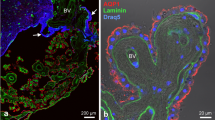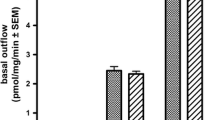Summary
Intraventricular perfusion of 5-hydroxydopamine (5-OH-DA) leads to its accumulation on ventricular cell surfaces and in the extracellular space of most periventricular brain regions. Thus, using a cytochemical method for the selective demonstration of monoamines at the ultrastructural level, a highly electron-dense reaction product could be observed on the surface of ependymal cells (including cilia and microvilli) and choroid plexus epithelial cells (including their characteristic club-shaped microvilli). In most brain regions (caudate nucleus, hypothalamus, subcommissural organ, median eminence and floor of the fourth ventricle) the reaction product was not confined to the ventricular surface but was also observed within clefts between adjacent cells and extended up to endothelial cells of capillaries in the periventricular zone; the only exception in this respect was the choroid plexus whose intercellular clefts were devoid of electron-dense material. The accumulation of extracellular 5-OH-DA, in contrast to its known intraneuronal localization in storage granules, was reserpine resistant.
These results support the conclusion that 5-OH-DA permeates gap junctions between ependymal cells but is excluded by tight junctions which form continuous belts, e.g. between choroid plexus epithelial cells and capillarly endothelial cells. The presence of 5-OH-DA within clefts between tanycytes of the median eminence implies that their tight junctions are ‘leaky’ or macular (discontinuous) and do not provide a complete barrier to the penetration of the amine. Tight junctions of the choroid plexus epithelium and capillary endothelium seem to prevent small molecules, such as transmitters, from passing from blood to cerebrospinal fluid (CSF) and blood to brain as well as in the reverse direction.
Similar content being viewed by others
References
Aghajanian, G. K. andBloom, F. E. (1966) Electron-microscopic auto-radiography of rat hypothalamus after H3-norepinephrine.Science 153, 308–10.
Bertler, A., Falck, B., Owman, Ch. andRosengren, E. (1966) The localization of monoaminergic blood-brain barrier mechanisms.Pharmacological Reviews 18, 369–85.
Brightman, M. W. (1968) The intracerebral movement of protein injected into blood and cerebrospinal fluid of mice.Progress in Brain Research 29, 19–37.
Brightman, M. W., Prescott, L. andReese, T. S. (1975) Intercellular junctions of special ependyma. In:Brain-Endocrine Interaction II. The Ventricular System (edited byKnigge, K. M., Scott, D. E., Kobayashi, H. andIshii, S.), pp. 146–65. Basel: Karger.
Brightman, M. W. andReese, T. S. (1969) Junctions between intimately apposed cell membranes in the vertebrate brain.Journal of Cell Biology 40, 648–77.
Castel, M., Sahar, A. andErlij, D. (1974) The movement of lanthanum across diffusion barriers in the choroid plexus of the cat.Brain Research 67, 178–84.
Davson, H. (1976) The blood-brain barrier.Journal of Physiology 255, 1–29.
Farquhar, M. G. andPalade, G. E. (1963) Junctional complexes in various epithelia.Journal of Cell Biology 17, 375–412.
Hayden, J. F., Johnson, L. R. andMaickel, R. P. (1969) Construction and implantation of a permanent cannula for making injections into the lateral ventricle of the rat brain.Life Science 5, 1509–15.
Lee, J. C. (1971) Evolution in the concept of the blood-brain barrier phenomenon.Progress in Neuropathology 1, 84–145.
Reese, T. S. andBrightman, M. W. (1968) Similarity in structure and permeability to peroxidase of epithelia overlying fenestrated cerebral capillaries.Anatomical Record 160, 414.
Revel, J. P. andKarnovsky, M. J. (1967) Hexagonal array of subunits in inter-cellular junctions of the mouse heart and liver.Journal of Cell Biology 33, C7.
Richards, J. G. andTranzer, J. P. (1970) The ultrastructural localization of amine storage sites in the central nervous system with the aid of a specific marker, 5-hydroxydopamine.Brain Research 17, 463–9.
Richards, J. G., Lorez, H. P. andTranzer, J. P. (1973) Indolealkylamine nerve terminals in cerebral ventricles: Identification by electron microscopy and fluorescence histochemistry.Brain Research 57, 277–88.
Schmitt, F. O. andSamson, F. E. (1969) Brain cell microenvironment.Neuroscience Research Program Bulletin 7, 317–29.
Tranzer, J. P. andRichards, J. G. (1976) Ultrastructural cytochemistry of biogenic amines in nervous tissue: Methodological improvements.Journal of Histochemistry and Cytochemistry 24, 1178–93.
Author information
Authors and Affiliations
Rights and permissions
About this article
Cite this article
Richards, J.G. Permeability of intercellular junctions in brain epithelia and endothelia to exogenous amine: cytochemical localization of extracellular 5-hydroxydopamine. J Neurocytol 7, 61–70 (1978). https://doi.org/10.1007/BF01213460
Received:
Revised:
Accepted:
Issue Date:
DOI: https://doi.org/10.1007/BF01213460




